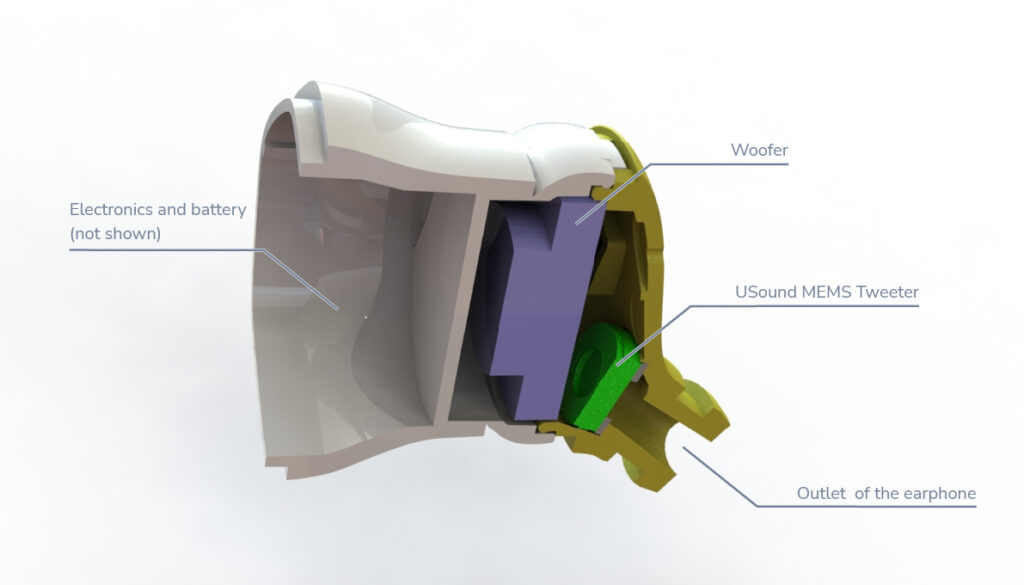Using MEMS technology for speakers is still a relatively new introduction to the market of miniature speakers. Such MEMS loudspeakers have been tested and used in different applications and stirred up the waters; however, they have not yet found their ideal niche to make their big market entry. So far, the most promising application for them is with in-ear headphones, where they can be used not only in a full-range application but also specifically as tweeters, as clearly shown by the latest developments at USound and in the market.
Why are tweeters needed for in-ear headphones?
There are multiple reasons why earphones benefit from a dedicated tweeter speaker. The first is that if one looks at Hi-Fi systems, it is absolutely normal to have multiple speakers covering separate frequency ranges. Using a 2-way system consisting of a tweeter and a woofer in one cabinet is the de-facto standard by now. This is more or less a given for any Hi-Fi System that is not part of the absolute lowest price segment. Sometimes, especially in home cinema systems, there is even a 3rd speaker in the form of a subwoofer. In analogy to that, using separate tweeters also in in-ear headphones is the logical next step in improving sound quality – regardless of whether they are wired or wireless. This increases opportunities to select different speakers for different frequency regions, which in turn means that the individual speakers can be optimized for those regions. A one-size-fits-all approach is not needed anymore.
Another significant argument building on the previous one is ANC. While it would not be technically correct to claim that an added tweeter will improve the ANC itself directly, it allows for more flexibility in improving and optimizing the woofer for the task. Generally speaking, active noise canceling capabilities place a quite high demand on speakers. For example, the requirement for high excursion becomes more grave when ANC is used, as the earphone system needs to be able to compensate for the large amount of controlled leakage necessary to ensure stable performance over repeated inserts of the earphone into the ear. With the requirement of having the highest excursions possible, sacrifices in the high-frequency reproduction are necessary. In other words: a speaker that can do it all (the high excursion for ANC and the precision required for properly creating the high frequencies) is tough to design and produce consistently. Splitting this requirement up into a woofer speaker covering the high excursion demand and a tweeter, which can subsequently be optimized for the high frequencies, gives a lot of advantages. It will bring manufacturers closer to achieving their desired sound profile. There is even a third argument: If one looks at professional in-earphones, like the ones used for in-ear monitoring on stages for musicians, they often use multiple speakers to improve sound quality as well. They typically combine different BA speakers (balanced armatures) and try to optimize the sound by just adding multiple of those. Of course, this is a relatively expensive approach, but it gets the job of achieving perfect audio quality done. This again shows the general trend in earphones of combining multiple speakers to a 2(or multi)-way system.
What makes a good tweeter?
The first and foremost task of a tweeter is to achieve high SPL levels at high frequencies. To achieve this, the moving mass needs to be small because at equal force from the motor, a lower mass yields a higher acceleration of the diaphragm and hence a higher SPL at high frequencies. The moving mass has a lower limit with electrodynamic moving-coil speakers, since the heavy copper coil can only be made so light before its force output is reduced too much. This issue is reduced with the use of a balanced-armature design, where the coil is not moving – but these too have downsides, where the stiff diaphragm typically has strong resonances, and the form factor limits high-frequency performance through its front volume Helmholtz resonance. Therefore it is fair to say that the MEMS speakers have an inherent advantage in this regard because the mass of the silicon is very, very small. Additionally, membrane modes – which often compromise high-frequency performance – are omitted due to the delicate motor system. In conclusion, it is fair to say the MEMS speaker technology clearly shows the highest potential for designing ideal tweeters.
| Speaker Type | Force | Low moving mass |
| Electro dynamic | + | – – |
| Balanced Armature | o | o |
| USound MEMS | o | ++ |
Challenges in the integration
While the acoustic benefits of a separate tweeter are clear, it does take up space – and space is not available in abundance in a modern wireless earphone since customers demand an ever-growing list of capabilities from their earphones, all of which require additional hardware to be crammed into the tiny shell. So a tweeter needs to be as small and thin as possible! A round form factor is also advantageous, as round speakers tend to be easier to fit into the industrial design of a TWS, which can then have a more organic round shape. Another topic that can not be overlooked is the influence of the integration on the actual sound performance for the listener. So, for example, with BA speakers, one might believe the integration to be relatively easy due to their small size and simple, rectangular shape – but this is not the case. While the rectangular shape might be the lesser problem, the form factor with a front output spit makes it hard to implement them without causing extra resonances. There is always a long channel needed to connect the BA to the ear, which will produce additional resonances, coloring the sound in an unwanted way. This subsequently degrades the acoustic performance delivered to the user. So for the perfect tweeter, it is very relevant that it can be integrated directly into the outlet of the in-earphone.
How have others solved this problem?
There is, of course, the option of simply having only a 1-way system with a single full-range speaker. This has worked in the past and produced some excellent products that fulfilled market expectations. However, users have higher standards nowadays, and manufacturers need to set themselves apart from the crowd. Furthermore, TWS have a quite high price tag, leading customers to expect only the best.
As mentioned before, it is very likely that with a 1-way system, a compromise needs to be made between high frequencies and low frequencies reproduction. This typically goes to the high frequencies’ expenses because no one wants to compromise on bass. Another remedy is using BAs (Balanced Armatures). They are simply smaller. That’s why one can pack multiple BA’s together. Alternatively, even hybrid solutions with an electrodynamic speaker for the bass region and a BA as tweeter are possible. Nevertheless, there is always the challenge of integration, mainly because the electrodynamic speakers are usually round, and the BAs are exclusively rectangular. So there is always a mismatch of form factors, which is quite a considerable challenge for the integration. Nevertheless, it has been done rather successfully in some very high-end earphones. The logical next step is to make this accessible in more reasonably priced (but still premium) earphones that target a larger pool of customers.
How USound speakers enable a better solution
Combining the above mentioned, it becomes pretty clear that, on the one hand, there is a lack of suitable tweeter products for in-earphones with the old technologies. While on the other hand, a trend is emerging encouraging manufacturers to offer 2-way systems as the next logical improvement step in TWS for the masses.
With the electrodynamic technology and the BAs, it is unclear if they can act like the kind of tweeters that the earphone industry needs. Instead, MEMS speakers, especially USound MEMS speakers, are starting to show their inherent potential clearly. It generally seems like a very good point in time for tweeter solutions to be integrated into earphones for multiple reasons. One is that the current TWS market appears to have reached a relatively stable state. All the initial problems of battery lifetime, usability, etc., were solved, at least to an acceptable extent. That is why manufacturers are now looking to improve the product even further. So that’s one reason why tweeters in in-earphones are probably the next big thing. USound speakers show an inherent advantage as tweeters because of the low moving mass, which gives the speakers high SPL from the get-go. Furthermore, the typical flat and round shape of USounds second-generation speakers, Conamara, fits way nicer into any earphone shape than comparable competitors. So there is a clear integration advantage, which subsequently enables way better acoustic designs.

Concluding words
We from USound see a clear advantage in using MEMS tweeters in in-earphones. On one side, we see a strong trend in the TWS market for new improvements in sound and sound-related features (individual audio tuning, ANC, transparency mode). On the other hand, we know that USound MEMS speakers produce an inherently more precise movement, which is especially important for the accurate reproduction of high frequencies. As a third reason, the acoustic integration of a USound tweeter makes fewer compromises necessary. Combining this with the technological advantage in terms of SPL right from the get-go, it becomes clear that with USound MEMS tweeters, an overall optimized sound performance can be achieved.

About the author
Jakob Spötl is the Head of Acoustics at USound, where he drives innovation in MEMS audio technology. With a solid background in acoustic engineering and more than a decade of experience in the MEMS audio industry, Jakob plays a crucial role in shaping USound’s technological advancements. LinkedIn


